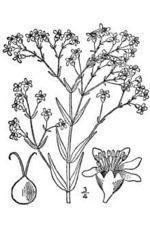Baby's-breath
| Baby's-breath |
|---|

|
| Scientific Classification |
|
| Species |
|
Baby's-breath are any of the species of flowering plants belonging to the taxonomic genus Gypsophila. They can mostly be found in the northern United States and Canada, and it can be used as a floral design, most often, to complement a rose bouquet. Usually the seeds of this plant are blown off by the wind but other times they will be carried on the parent plant and then dropped on the ground. Baby's-breath can also carry up to 13,700 seeds on it.
Anatomy
The baby's-breath is a small sweet scented flower that has 5 sepals and 5 petals. This flower is also used widely as a floral arrangements. The leaves on this flower are opposite and they have a lance shape to them. The fruit is a capsule that has 2-5 seeds on it, and the seeds a black and kidney shaped.[1] They have flowering branches that grow all the flower, and it can grow up to 3 feet, the stem also has a bluish green color.
Reproduction
Baby's-breath can have as many as 13,700 seeds on it. When the wind blows it is one of the ways that the seeds get around, it is also one of the most important ways.[2] Most of the seeds will be dropped on the ground near the parent plant. If some of the seeds don't open, they will be carried on the parent plant until they are dropped. The seeds have little or no dormancy, and germination occurs when the temperature is between 10-28 centigrade.
Ecology
The baby's-breath was first introduced in Europe and the way that it spreads is that when the flower is mature enough it will break off and roll in the wind and spread its seeds.[3] There are also several annual garden varieties of this flower. It usually grows in waste areas, roadsides, and pastures-seems to thrive in dry, sandy soils. It is also very commonly known in the northern parts of the northern United States and Canada.





